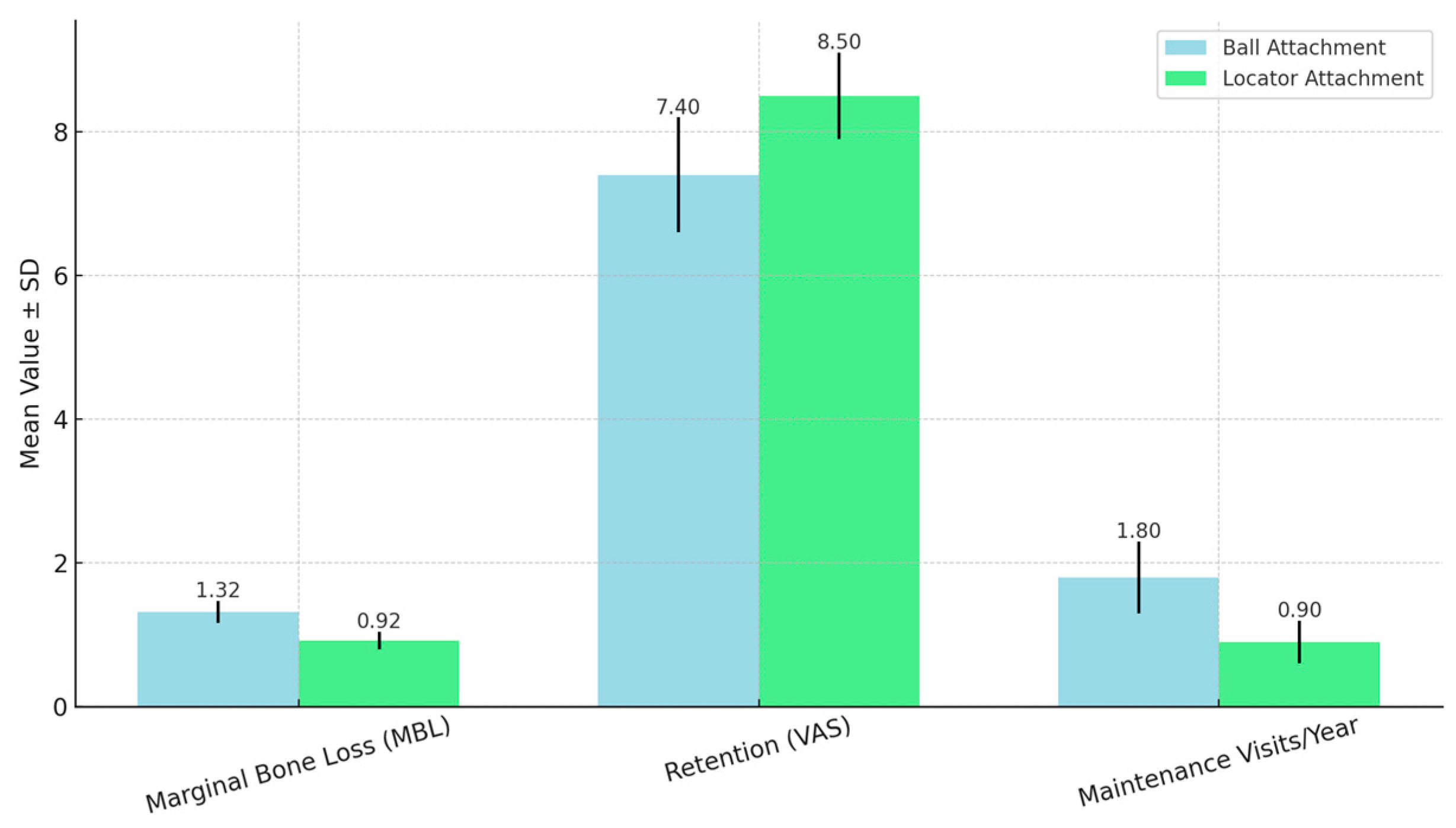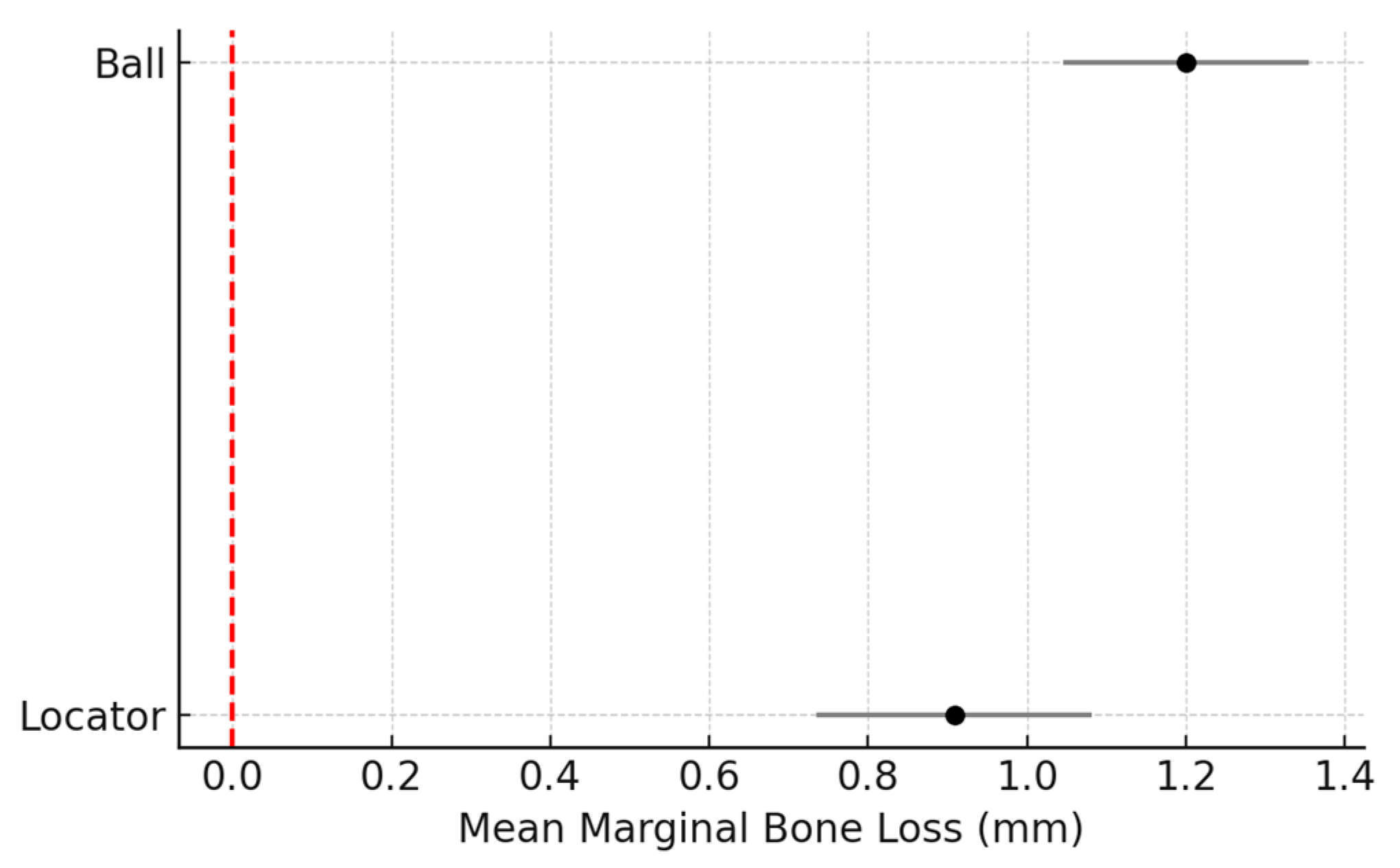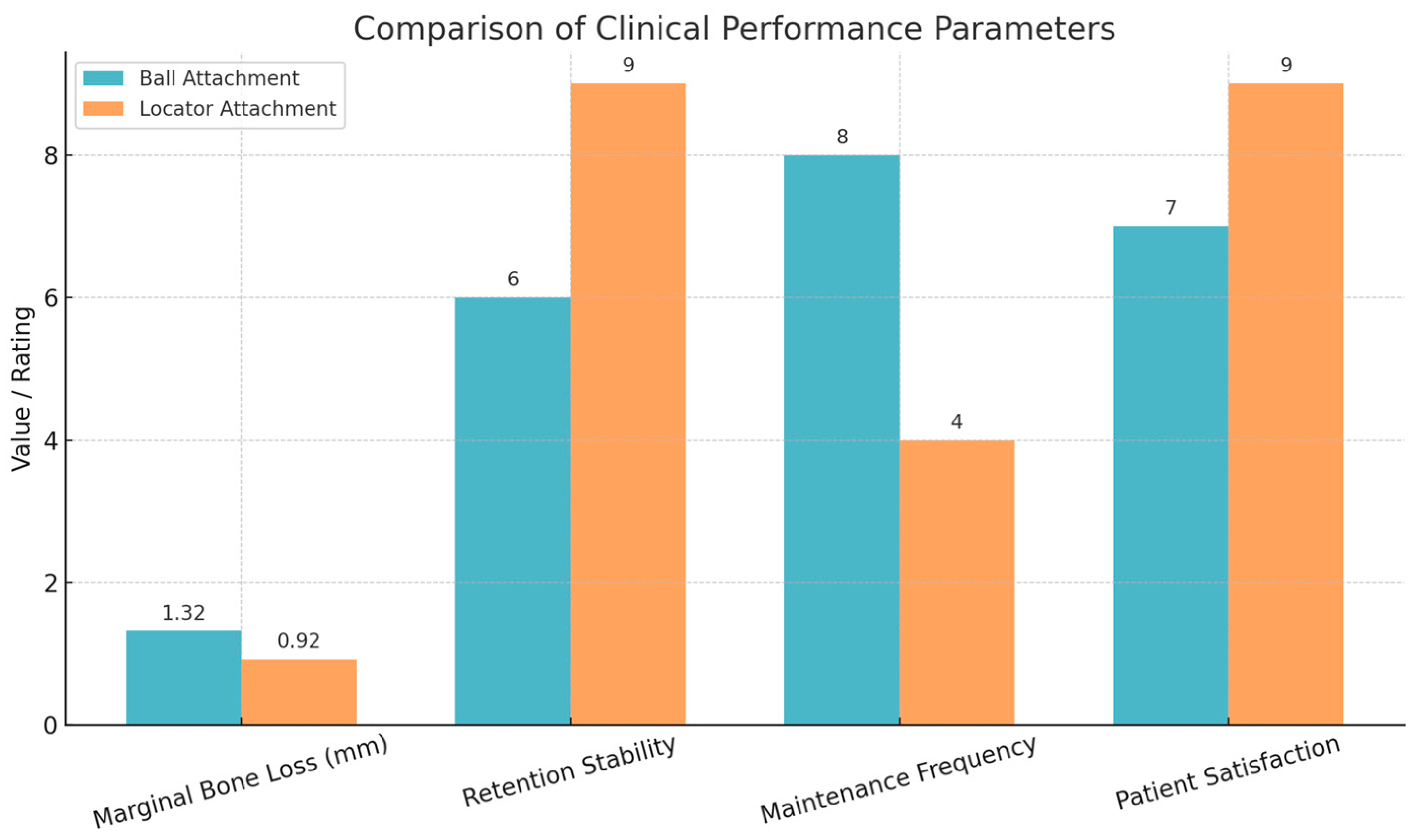Ball vs. Locator Attachments in Mandibular Overdentures: A Narrative Review of Clinical Performance and Patient Outcomes
Abstract
1. Introduction
2. Materials and Methods
3. Results
3.1. Marginal Bone Loss (MBL)
| Study (Author, Year) | Attachment Type | Sample Size | MBL (mm) | Retention Loss (Cases) | Complications | Follow-up Duration | Study Design | Country |
|---|---|---|---|---|---|---|---|---|
| Thomason et al. (2009) [2] | Ball | 30 | 1.2 | 2 | 1 sore spot | 12 months | RCT | UK |
| Sadowsky (2001) [3] | Locator | 30 | 0.9 | 1 | None | 12 months | Prospective | USA |
| Bilhan et al. (2011) [4] | Ball | 28 | 1.1 | 3 | 2 inflammations | 60 months | Prospective | Turkey |
| Sadig (2010) [5] | Locator | 28 | 0.95 | 1 | 1 pain episode | 24 months | RCT | Saudi Arabia |
| Gupta et al. (2023) [6] | Ball | 26 | 1.3 | 3 | 1 swelling | 36 months | Systematic Review | India |
| El-Sheikh et al. (2012) [7] | Locator | 26 | 1.0 | 1 | None | 12 months | RCT | Egypt |
| Kleis et al. (2010) [8] | Ball | 32 | 1.05 | 2 | 2 ulcers | 36 months | Comparative | Germany |
| Dudic and Mericske-Stern (2012) [9] | Locator | 32 | 0.85 | 0 | 1 irritation | 24 months | Comparative | Switzerland |
| Ertugrul et al. (2021) [10] | Ball | 24 | 1.15 | 2 | None | 12 months | RCT | Turkey |
| Marcello-Machado et al. (2021) [14] | Locator | 24 | 0.88 | 1 | 1 sore spot | 12 months | RCT | Brazil |
| Bielemann et al. (2021) [15] | Ball | 25 | 1.12 | 2 | 1 mucositis | 12 months | RCT | Brazil |
| Mundt et al. (2015) [16] | Ball | 20 | 1.2 | 1 | None | 24 months | Prospective | Germany |
| Catalán et al. (2016) [17] | Ball | 22 | 1.25 | 3 | 2 pain complaints | 84 months | Cohort | Chile |
| Preoteasa et al. (2012) [18] | Locator | 30 | 0.93 | 2 | 1 soreness | 12 months | Observational | Romania |
| Jofré et al. (2010) [19] | Ball | 19 | 1.35 | 2 | None | 24 months | RCT | Chile |
| Stanford et al. (2016) [20] | Locator | 21 | 0.87 | 1 | 1 mild bleeding | 36 months | RCT | USA |
| Maryod et al. (2014) [21] | Ball | 20 | 1.28 | 2 | 1 sore spot | 60 months | Case Series | Egypt |
| Mangano et al. (2014) [22] | Locator | 18 | 0.89 | 1 | None | 120 months | Prospective | Italy |
3.2. Retention Loss and Need for Maintenance
3.3. Biological and Technical Complications
3.4. Patient-Reported Outcomes
3.5. Survival Data

4. Discussion
Limitations
5. Conclusions
Author Contributions
Funding
Conflicts of Interest
References
- Feine, J.S.; Carlsson, G.E.; Awad, M.A.; Chehade, A.; Duncan, W.; Gizani, S.; Head, T.; Lund, J.P.; MacEntee, M.; Mericske-Stern, R.; et al. The McGill consensus statement on overdentures. Int. J. Prosthodont. 2002, 15, 413–414. [Google Scholar]
- Thomason, J.M.; Kelly, S.A.; Bendkowski, A.; Ellis, J.S. Two-implant-retained overdentures: A review of the literature supporting the McGill and York consensus statements. J. Dent. 2009, 37, 27–32. [Google Scholar] [CrossRef] [PubMed]
- Sadowsky, S.J. Mandibular implant-retained overdentures: A literature review. J. Prosthet. Dent. 2001, 86, 468–473. [Google Scholar] [CrossRef] [PubMed]
- Bilhan, H.; Erdogan, O.; Ergin, S.; Celik, M.; Ates, G.; Geckili, O. Complication rates and patient satisfaction with removable dentures retained by ball, bar, and Locator attachments: Five-year follow-up. J. Adv. Prosthodont. 2012, 4, 109–115. [Google Scholar] [CrossRef]
- Sadig, W. A comparative study of the performance of two commercially available overdenture attachment systems. J. Prosthodont. 2010, 19, 24–30. [Google Scholar] [CrossRef]
- Gupta, N.; Bansal, R.; Shukla, N.K. The effect of ball versus Locator attachment system on the performance of implant-supported overdenture: A systematic review. J. Oral. Biol. Craniofacial Res. 2023, 13, 44–55. [Google Scholar] [CrossRef]
- El-Sheikh, A.M.; Shihata, L.A.; Fayed, M.S. Influence of different attachment systems on peri-implant tissues of mandibular overdentures: A one-year randomized clinical trial. J. Oral. Implantol. 2012, 38, 395–403. [Google Scholar] [CrossRef]
- Kleis, W.K.; Kämmerer, P.W.; Hartmann, S.; Al-Nawas, B.; Wagner, W. A comparison of three attachment systems for mandibular two-implant overdentures. Clin. Implant. Dent. Relat. Res. 2010, 12, 209–218. [Google Scholar] [CrossRef]
- Dudic, A.; Mericske-Stern, R. Retention mechanisms and prosthetic complications in mandibular overdentures: A comparison of three attachment systems. Int. J. Prosthodont. 2012, 25, 244–250. [Google Scholar]
- Ertugrul, A.S.; Patel, S.; Vaishnav, K. Comparative Evaluation of Various Implant Overdenture Attachment Systems in Terms of Survival Rate, Tissue Response, and Patient Satisfaction: A Systematic Review and Meta-Analysis. Cureus 2025, 17, e83838. [Google Scholar] [CrossRef]
- Rosa, A.; Pujia, A.M.; De Angelis, R.; Arcuri, C. Narrow implants and overdentures in the total rehabilitation of atrophic edentulous jaws: Review of clinical aspects with meta-analysis. Prosthesis 2024, 6, 41–52. [Google Scholar] [CrossRef]
- Rosa, A.; Pujia, A.M.; Arcuri, C. Complete full-arch supported by short implant (<8 mm) in edentulous jaw: A systematic review. Appl. Sci. 2023, 13, 7162. [Google Scholar] [CrossRef]
- Barlattani, A., Jr.; Martelli, M.; Gargari, M.; Ottria, L. Articular disc of the temporomandibular joint: An anatomical and histological study—Functional considerations. J. Biol. Regul. Homeost. Agents. 2019, 33 (Suppl. S2), 199–208. [Google Scholar] [PubMed]
- Marcello-Machado, R.M.; Faot, F.; Schuster, A.J.; Bielemann, A.M.; Chagas Júnior, O.L.; Del Bel Cury, A.A. One-year clinical outcomes of locking-taper Equator attachments retaining mandibular overdentures on narrow-diameter implants. Clin. Implant. Dent. Relat. Res. 2022, 24, 225–234. [Google Scholar] [CrossRef] [PubMed]
- Bielemann, A.M.; Schuster, A.J.; Possebon, A.P.D.R.; Schinestsck, A.R.; Chagas-Junior, O.L.; Faot, F. Clinical performance of narrow-diameter implants with hydrophobic and hydrophilic surfaces retaining mandibular overdentures: One-year randomized clinical trial. Clin. Oral. Implant. Res. 2021, 33, 21–32. [Google Scholar] [CrossRef] [PubMed]
- Mundt, T.; Schwahn, C.; Biffar, R.; Heinemann, F. Changes in bone levels around mini-implants in edentulous arches. Int. J. Oral. Maxillofac. Implants. 2015, 30, 1149–1155. [Google Scholar] [CrossRef] [PubMed]
- Catalán, A.; Martínez, A.; Marchesani, F.; González, U. Mandibular overdentures retained by two mini-implants: Seven-year retention and satisfaction study. J. Prosthodont. 2016, 25, 364–370. [Google Scholar] [CrossRef]
- Preoteasa, E.; Marin, M.; Imre, M.; Lerner, H.; Preoteasa, C.T. Patients’ satisfaction with conventional dentures and mini-implant-anchored overdentures. Rev. Med. Chir. Soc. Med. Nat. Iasi. 2012, 116, 310–316. [Google Scholar] [PubMed]
- Jofré, J.; Conrady, Y.; Carrasco, C. Survival of splinted mini-implants after contamination with stainless steel. Int. J. Oral. Maxillofac. Implants. 2010, 25, 351–356. [Google Scholar] [PubMed]
- Stanford, C.M.; Barwacz, C.; Raes, S.; De Bruyn, H.; Cecchinato, D.; Bittner, N.; Brandt, J. Multicenter randomized clinical trial evaluation of an implant system designed for enhanced primary stability. Int. J. Oral. Maxillofac. Implant. 2016, 31, 906–915. [Google Scholar] [CrossRef]
- Maryod, W.; Ali, S.; Shawky, A. Technical complications and failures of zirconia-based prostheses supported by implants followed up to seven years: A case series. Int. J. Prosthodont. 2014, 27, 553–560. [Google Scholar] [CrossRef] [PubMed]
- Mangano, F.; Shibli, J.A.; Sammons, R.L.; Veronesi, G.; Piattelli, A.; Mangano, C. Clinical outcome of narrow-diameter (3.3 mm) locking-taper implants: A prospective study with 1 to 10 years of follow-up. Int. J. Oral. Maxillofac. Implant. 2014, 29, 448–455. [Google Scholar] [CrossRef] [PubMed]
- Hasan, I.; Madarlis, C.; Keilig, L.; Dirk, C.; Weber, A.; Bourauel, C.; Heinemann, F. Changes in biting forces with implant-supported overdenture in the lower jaw: A comparison between conventional and mini-implants in a pilot study. Ann. Anat. 2016, 208, 116–122. [Google Scholar] [CrossRef] [PubMed]
- Temizel, S.; Heinemann, F.; Dirk, C.; Bourauel, C.; Hasan, I. Clinical and radiological investigations of mandibular overdentures supported by conventional or mini-dental implants: Two-year prospective follow-up. J. Prosthet. Dent. 2017, 117, 239–246.e2. [Google Scholar] [CrossRef]
- Jawad, S.; Clarke, P. Survival of mini dental implants used to retain mandibular complete overdentures: Systematic review. Int. J. Oral. Maxillofac. Implant. 2019, 34, 343–356. [Google Scholar] [CrossRef]
- Fiorillo, L.D.; D’amico, C.D.; La Rosa, G.R.M.; Calanna, F.D.; Pappalardo, A.D.; Pedullà, E.D. Experimental anatomic CBCT study on correlations between MB1 and MB2 canals in the mesiobuccal root of maxillary first molars. J. Craniofacial Surg. 2024, 35, 672–677. [Google Scholar] [CrossRef]
- Mohammadi, M.; Baker, E.; Chrcanovic, B.R. Clinical and radiographic outcomes of mini-implant-retained maxillary and mandibular overdentures: Systematic review and meta-analysis. Clin. Oral. Investig. 2025, 29, 1–14. [Google Scholar] [CrossRef]
- Zhang, G.; Li, J.; Li, J.; Zhou, X.; Xie, J.; Wang, A. Selective laser melting molding of individualized femur implant: Design, process, optimization. J. Bionic Eng. 2021, 18, 128–137. [Google Scholar] [CrossRef]
- Nagay, B.E.; Dini, C.; Borges, G.A.; Mesquita, M.F.; Cavalcanti, Y.W.; Magno, M.B.; Maia, L.C.; Barão, V.A.R. Clinical efficacy of anodized dental implants for implant-supported prostheses after different loading protocols: A systematic review and meta-analysis. Clin. Oral. Implant. Res. 2021, 32, 1021–1040. [Google Scholar] [CrossRef]



Disclaimer/Publisher’s Note: The statements, opinions and data contained in all publications are solely those of the individual author(s) and contributor(s) and not of MDPI and/or the editor(s). MDPI and/or the editor(s) disclaim responsibility for any injury to people or property resulting from any ideas, methods, instructions or products referred to in the content. |
© 2025 by the authors. Licensee MDPI, Basel, Switzerland. This article is an open access article distributed under the terms and conditions of the Creative Commons Attribution (CC BY) license (https://creativecommons.org/licenses/by/4.0/).
Share and Cite
Miranda, M.; Bollero, P.; Rosa, A.; Gargari, M.; Martelli, M. Ball vs. Locator Attachments in Mandibular Overdentures: A Narrative Review of Clinical Performance and Patient Outcomes. Prosthesis 2025, 7, 100. https://doi.org/10.3390/prosthesis7040100
Miranda M, Bollero P, Rosa A, Gargari M, Martelli M. Ball vs. Locator Attachments in Mandibular Overdentures: A Narrative Review of Clinical Performance and Patient Outcomes. Prosthesis. 2025; 7(4):100. https://doi.org/10.3390/prosthesis7040100
Chicago/Turabian StyleMiranda, Michele, Patrizio Bollero, Alessio Rosa, Marco Gargari, and Mirko Martelli. 2025. "Ball vs. Locator Attachments in Mandibular Overdentures: A Narrative Review of Clinical Performance and Patient Outcomes" Prosthesis 7, no. 4: 100. https://doi.org/10.3390/prosthesis7040100
APA StyleMiranda, M., Bollero, P., Rosa, A., Gargari, M., & Martelli, M. (2025). Ball vs. Locator Attachments in Mandibular Overdentures: A Narrative Review of Clinical Performance and Patient Outcomes. Prosthesis, 7(4), 100. https://doi.org/10.3390/prosthesis7040100








